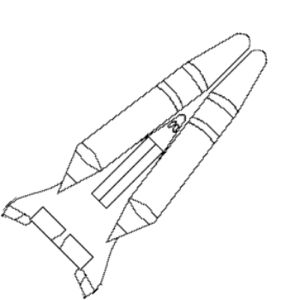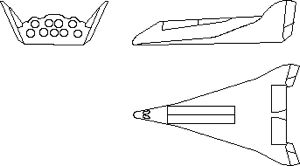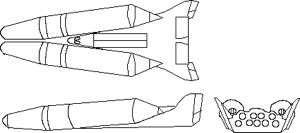
Home - Search - Browse - Alphabetic Index: 0- 1- 2- 3- 4- 5- 6- 7- 8- 9
A- B- C- D- E- F- G- H- I- J- K- L- M- N- O- P- Q- R- S- T- U- V- W- X- Y- Z
Shuttle LS200
 LS-200 160 pixels Credit: © Mark Wade |
AKA: Starclipper. Status: Study 1971. Thrust: 21,214.40 kN (4,769,187 lbf). Gross mass: 1,730,803 kg (3,815,767 lb). Height: 57.00 m (187.00 ft). Diameter: 4.57 m (14.99 ft).
Lockheed designed a version of their earlier 1.5 stage-to-orbit 'Starlifter' concepts meeting NASA requirements. Two versions were proposed: an LS-200-10, which would be a 1.5 stage to orbit vehicle, and the LS-200-8 and -5, which could later be uprated to the LS-400-7A two-stage-to-orbit. The Lockheed designs were all high-fineness lifting bodies derived from their 1968 LSC-8MX design for the USAF ILRV requirement. The 47.7 m long orbiter was surrounded at launch by a 58.5 m high x 8.23 m diameter V-shaped drop tank. The advantages of the design were that only a single complex vehicle needed to be designed, built, flight tested and maintained. At the same time, if at a later time an all-recoverable two-stage-to-orbit launcher was needed, the already developed and paid for orbiter could serve as the second stage of such a system. Lockheed also maintained that their delta-body design would be 9,000 kg lighter than an equivalent delta wing, while still having the same 2783 km cross-range.
The Lockheed design featured an aluminum airframe, a titanium thrust structure, an LI-1500 tile thermal protection system, and a tantalum alloy nose-cap able to withstand 1650 deg C. The V-tank would be dropped at 19,800 kph, at a zero aerodynamic pressure. The booster for the two-stage variant was a scaled-up version of the McDonnell Douglas/Martin Marietta Phase B design. The orbiter in the two-stage version would delete the drop tank, seven of the nine engines, and two turbojets. The positions of the internal tanks would be reversed to compensate for the center of gravity change created by deletion of the seven engines. Lockheed estimated there would be an 5200 kg weight penalty for an orbiter created for 1.5 stage to orbit and later used for two stage to orbit, as opposed to one designed only as the second stage.
Lockheed planned to built two ground and three flight test vehicles in an $ 8 billion development program which would lead to a first flight by April 1975. The expendable drop tank would consume 24% of this amount. Cost per flight was estimated as $ 7.1 million, declining to $6.3 million by the 416th flight.
Stage Data - Shuttle LS200
- Stage 1. 1 x Shuttle LS200-1. Gross Mass: 1,730,803 kg (3,815,767 lb). Empty Mass: 133,514 kg (294,347 lb). Thrust (vac): 27,422.001 kN (6,164,711 lbf). Isp: 455 sec. Burn time: 256 sec. Isp(sl): 352 sec. Diameter: 4.57 m (14.99 ft). Span: 28.05 m (92.02 ft). Length: 47.71 m (156.52 ft). Propellants: Lox/LH2. No Engines: 9. Engine: SSME Study. Other designations: Starlifter. Status: Study 1971 June. Comments: High-fineness lifting-body configuration. Cross Range 2,419 km.
Family: orbital launch vehicle, Winged. Country: USA. Engines: SSME Study. Stages: Shuttle LS200-1. Agency: Lockheed.
 | LS-200 Orbiter Credit: © Mark Wade |
 | LS-200 LS-200 launch vehicle 3 view Credit: © Mark Wade |
Back to top of page
Home - Search - Browse - Alphabetic Index: 0- 1- 2- 3- 4- 5- 6- 7- 8- 9
A- B- C- D- E- F- G- H- I- J- K- L- M- N- O- P- Q- R- S- T- U- V- W- X- Y- Z
© 1997-2019 Mark Wade - Contact
© / Conditions for Use